How Much Does a Sauna Cost to Run?

Beyond the installation cost, how much does a sauna really cost to run? The operating costs of a sauna vary depending on its size, type, and frequency of use. And then there’s also the difference between an electric sauna and a firewood-heated sauna, which will favor you depending on your setup and resources.
This guide explores the various factors that affect sauna costs, and provides actionable tips to save money while maximizing efficiency. By the end of this article, you’ll have a clear picture of what it takes to maintain your sauna experience without straining your budget.
Knowing the factors that influence running expenses can help you make the most of your investment for outdoor/ indoor saunas of your choice.
Key Takeaways
- The heater size is primarily determined by the sauna’s features and characteristics, primarily its volume, BUT with adjustments needed for additional factors such as glass surfaces, insulation quality, and ventilation.
- Frequent or longer sauna sessions increase electrical or firewood consumption. It is important to consider standby heating time as well.
- Electricity Costs Vary by Region: Based on average household consumption and regional rates, monthly electricity costs for electric saunas range from approximately AUD 102.16 in Queensland to AUD 170.33 in Tasmania. Assumptions include consistent annual usage by 2–3 person households.
- Firewood heating costs are often fractional compared to electricity, especially for users with local firewood supplies or areas where electricity connections are costly or unavailable.
- Energy Efficiency Tips for Lower Costs: Using off-peak electricity, modern energy-efficient heaters, and properly insulating the sauna can significantly reduce running costs.
Factors Influencing Sauna Running Costs
The cost of running a sauna isn’t a one-size-fits-all calculation—it depends on several key factors that vary from one setup to another. From the size of the sauna and the type of heater you choose to how often and how long you use it, these variables play a significant role in determining operating expenses.
Additionally, insulation quality, energy rates, and even the materials used in sauna construction can greatly impact efficiency and costs. By understanding these factors, you can make informed decisions to optimize your sauna experience and manage expenses effectively.
Sauna Features
1. Size of the Sauna
The foundational step in selecting a heater is assessing the sauna’s volume. Typically, a sauna heater requires approximately 1 kW of power to heat 1.25 to 1.5 cubic meters (or 35 to 50 cubic feet) of space. This calculation provides a baseline, but additional factors can modify this requirement.
2. Glass Surfaces
Glass surfaces in saunas, such as doors or windows, contribute to increased heat loss due to their lower insulation properties compared to wood. To maintain optimal temperatures and compensate for this heat loss, adjustments to the sauna heater size are necessary.
Adjusting for Glass Area
For every square meter of glass, add approximately 0.4 cubic meters to the sauna’s total volume when calculating heater size. This adjustment ensures the heater can adequately handle the additional heat loss caused by glass.
3. Sauna Insulation
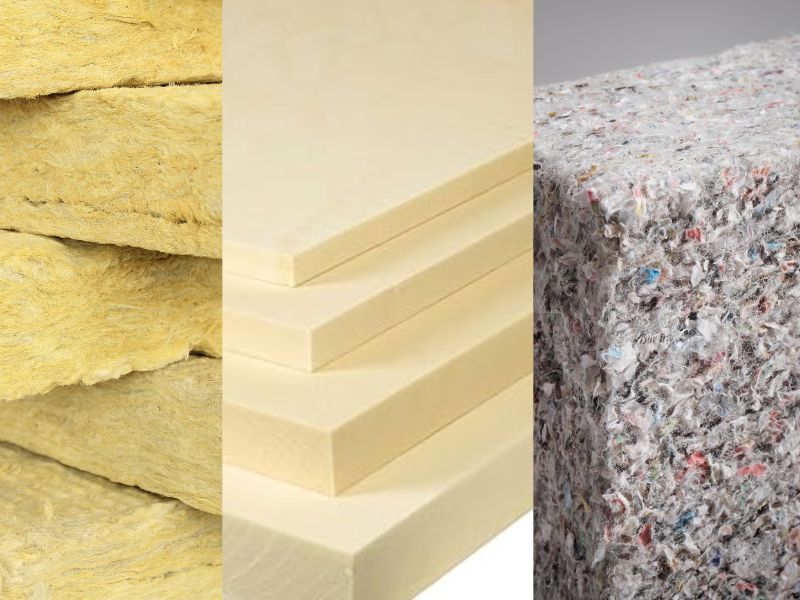
Various insulation materials | Shym Saunas
Good insulation significantly reduces heat loss, making your sauna more energy-efficient. Poor insulation can cause heaters to work harder, increasing running costs. Consider these materials:
- Fiberglass Insulation: A popular and cost-effective option for saunas, helping retain heat effectively.
- Reflective Barriers: Aluminum foil or similar materials can enhance heat retention by reflecting warmth back into the sauna.
- Wood Types for Sauna Construction: Durable and heat-retaining woods like cedar, hemlock, and spruce are ideal. They not only improve energy efficiency but also add a pleasant aroma to the sauna experience.
For detailed insulation tips, refer to Shym Saunas’ guide on sauna insulation.
4. Ventilation
Proper ventilation is essential for ensuring air quality, temperature regulation, and overall sauna comfort. However, ventilation openings can lead to heat loss, which may require adjustments to your heater size to maintain optimal temperatures.
- Vent Placement: Position intake vents near the heater and exhaust vents in the upper opposite corner of the sauna for efficient airflow.
- Vent Size: Ensure vent dimensions are appropriate for your sauna’s volume and heater capacity, as oversized vents can increase heat loss.
- Heater Adjustment: To compensate for ventilation-related heat loss, consult your sauna manufacturer or designer for specific recommendations on heater size adjustments based on your sauna’s design and vent configuration.
5. Structural Imperfections and Microgaps
No sauna is perfectly airtight, and structural imperfections, such as microgaps in the construction, can significantly impact heat retention. These tiny openings, often present in the joins between wooden panels, doors, or at the corners, allow warm air to escape and cooler air to enter, increasing the workload on the sauna heater.
Heat Loss Through Microgaps
- Increased Heater Workload:
- Microgaps force the heater to compensate for continuous heat loss, leading to higher energy consumption.
- The severity of heat loss depends on the size and quantity of the gaps, as well as the sauna’s insulation quality.
- Moisture and Air Infiltration:
- Gaps can allow moisture to infiltrate the sauna, potentially leading to faster degradation of wood and compromising the sauna’s longevity.
- In poorly sealed saunas, drafts can disrupt the even distribution of heat.
2. Frequency and Duration of Use
The frequency and duration of sauna use significantly affect your monthly costs. Beginners often start with short, infrequent sessions, but avid users may require multiple, longer sessions weekly.
| User Type | Session Duration | Weekly Use | Monthly Use |
| Beginner | 5–10 minutes | 1–2 sessions | 4–8 sessions |
| Moderate User | 15–20 minutes | 2–3 sessions | 8–12 sessions |
| Frequent User | 30 minutes or more | 4+ sessions | 16+ sessions |
Longer or more frequent sessions result in higher energy or fuel consumption. For example, increasing a session from 15 minutes to 30 minutes doubles energy use, especially for electric heaters that remain on longer.
NOTE: When computing running cost, do not forget to add and consider the standby heating time of the sauna, not only the actual sauna sessions.
Electrical Power Rates in Australia
This section provides a breakdown of electricity and firewood costs across different regions in Australia, along with the assumptions used in the calculations.
Electricity costs in Australia vary significantly depending on the region, household consumption, and electricity rates.
The electricity rates provided here are based on the AEMC’s Residential Electricity Price Trends 202 Report. The rates reflect the lowest offers from power companies, weighted by customer base, and multiplied by the average annual household usage for common household types in each state. These figures represent typical costs for 2–3 person households and provide a baseline for estimating sauna running costs.
Assumptions for Electricity Costs:
- Average Annual Consumption: Derived from typical 2-3 person households in each state, as per Momentum Energy’s analysis.
- Electricity Rates: Reflect both fixed supply charges and variable usage charges.
- Calculation Basis: Costs are calculated annually and monthly, assuming consistent usage throughout the year.
| State | Average Rate (¢/kWh) | Annual Consumption (kWh) | Annual Cost (AUD) | Monthly Cost (AUD) |
| QLD | 21.69 | 5,650 | $1,226 | $102.16 |
| NSW | 28.72 | 4,362 | $1,253 | $104.41 |
| ACT | 26.56 | 7,545 | $2,004 | $167.00 |
| VIC | 27.29 | 4,727 | $1,290 | $107.50 |
| SA | 34.84 | 5,000 | $1,742 | $145.67 |
| TAS | 26.67 | 7,666 | $2,044 | $170.33 |
Detailed Cost Analysis for Electrical Saunas

Electric saunas are convenient and easy to use, but their running costs depend on the heater’s power rating and your electricity rate.
To calculate energy consumption:
- Determine the heater’s kW rating (e.g., 6 kW).
- Multiply the kW by the hours of use per session.
- Multiply the result by the number of sessions per month.
Example calculation for a 6kW heater
- Heating Period (1 Hour): 6 kW × 1 hour = 6 kWh.
- Session Usage (15 Minutes): 6 kW × 0.25 hours = 1.5 kWh.
- Total Energy per Session: 6 kWh + 1.5 kWh = 7.5 kWh.
- Monthly Cost: 7.5 kWh × 8 sessions × $0.30 = $18/month.
- Note: This is an ideal calculation, assuming the sauna runs at 100% power all the time. But actually, most sauna heaters cycle on and off to maintain temperature, operating only approximately 60% of the time. This may change the actual costs depending on insulation and usage patterns, which includes the factors like number of people, weather conditions and others.
Energy-Efficiency Tips
- Energy-Efficient Heaters: Invest in modern, energy-efficient sauna heaters. These heaters consume less electricity while providing the same level of heat, further reducing your overall energy consumption.
- Use Off-Peak Energy: Schedule sauna sessions during off-peak hours when electricity rates are lower. This not only saves money but also reduces strain on the power grid.
Cost Analysis for Firewood-Heated Saunas
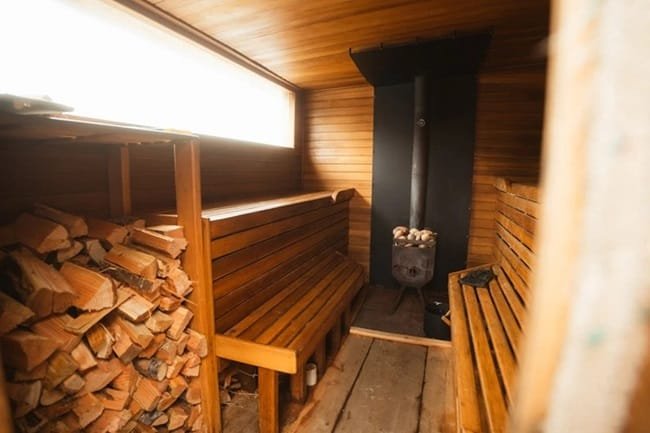
Photo Credit: Pexels
Firewood Consumption and Cost Considerations
The amount of firewood needed for a sauna session varies significantly based on several variables:
- Sauna Size: Larger saunas naturally require more wood to maintain the desired temperature.
- Amount of Stones: Saunas with larger stone masses need more energy to heat.
- Ventilation and Insulation: Poorly insulated saunas or those with significant ventilation can increase firewood consumption.
- Number of Users: More users generate additional moisture, requiring more heat to sustain the temperature.
Firewood prices depend on the type of wood and location. Depending where the hardwood is purchased the prices can range dramatically. For example, 1 cubic meter of hardwood in Tasmania is currently anywhere between $150 – $250.
Typically the cost of firewood will be more fractional than the cost of electricity per kW of heat produced, depending on the price of wood.
The Baseline: People who go for firewood heaters do so because of a special atmosphere in the sauna and because the firewood is abundant on their property. Of course, the connection of electricity is not feasible in some areas.
Choosing the Best Firewood for Saunas
Not all firewood is created equal. While some types are ideal for creating the steady heat required in saunas, others are better suited for campfires and toasting marshmallows. The key to enjoying a great sauna experience lies in understanding what wood works best and why.
Let’s explore the characteristics of effective firewood for saunas, proper storage practices, and why kiln-dried hardwood is the ultimate choice for a consistent and efficient sauna fire.
Softwoods vs. Hardwoods
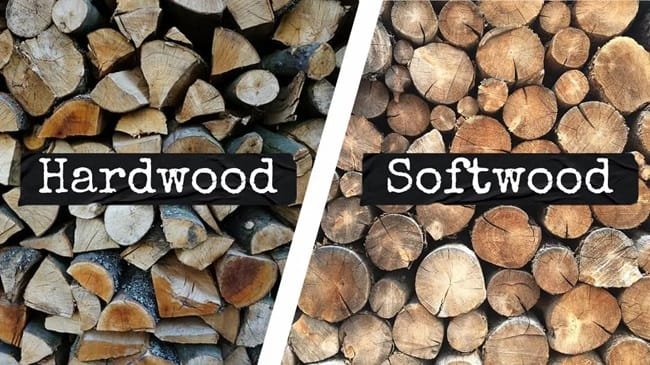
Photo Credit: Arrows UK
Softwoods: Great for Kindling
Softwood species like pine, cedar, fir, and spruce are excellent for starting fires due to their low density and high resin content, which helps them ignite quickly. Here’s why softwoods work as ideal kindling:
- Fast Ignition: Softwoods light easily and burn hot for a short duration, making them the perfect way to ignite hardwood logs.
- Pleasant Aroma: Burning softwoods often releases a subtle, incense-like fragrance that enhances the sauna’s ambiance.
Caution: Avoid overusing softwoods, especially resin-heavy species like eucalyptus and aspen. Excessive resin can produce “gunk” in your sauna stove, leading to inefficiencies, excessive smoke, and wear on your equipment.
Hardwoods for Steady, High Heat
Hardwoods, such as oak, birch, and maple, are the best choices for maintaining the steady, high heat needed for saunas. Their dense structure ensures a long-lasting and consistent burn, ideal for heating your sauna efficiently.
Benefits of Hardwood in Saunas:
- High Heat Output: Hardwoods burn hotter and for longer, providing steady warmth throughout your session.
- Less Smoke: Denser wood produces less smoke, reducing the likelihood of creosote buildup and creating a cleaner environment inside the sauna.
- Low Maintenance: Because of their slow burn, hardwoods require less frequent stoking, letting you relax and enjoy your sauna.
Why Kiln-Dried Hardwood is the Best Option
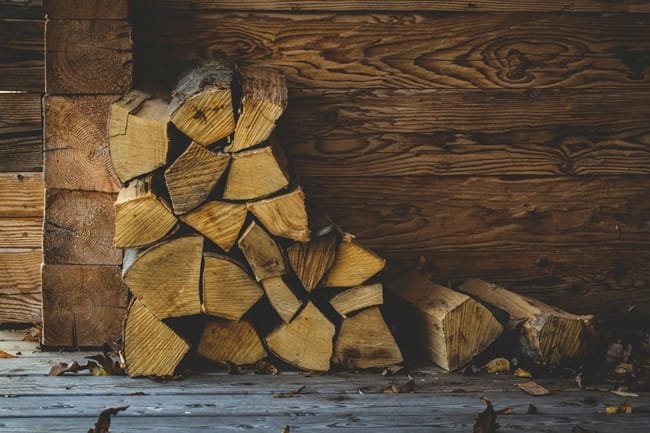
Photo Credit: Pexels
Kiln-dried hardwood is the premium choice for saunas, surpassing seasoned firewood in terms of efficiency and cleanliness. Here’s why:
- Lower Moisture Content:
Kiln-dried wood is dried in controlled conditions to reduce its moisture content to below 20%, making it burn more efficiently and produce less smoke compared to seasoned wood (moisture content around 40%). - Faster Ignition:
The reduced moisture makes kiln-dried wood easier to light and keeps the fire steady without constant adjustments. - Cleaner Burning:
Kiln-drying eliminates mold, mildew, and bugs from the wood, ensuring a healthier and more pleasant sauna experience. - Longer Burn Time:
Hardwood that has been kiln-dried burns hotter and for longer, reducing the amount of firewood you need per session.
Top Hardwood Species for Sauna Use
If you’re looking for the best hardwood species to fuel your sauna, consider these top options:
- Oak: The densest and most common hardwood, offering exceptional heat output and longevity.
- Birch: Provides high heat and long burn times, making it a classic choice for saunas.
- Maple: Produces minimal smoke and creosote, ideal for those sensitive to firewood smells.
- Ash: Readily available and easy to light, a convenient option for sauna owners.
- Cherry: Adds a fruity aroma to your sauna session, combining heat with a touch of aromatherapy.
- Hickory: Known for clean, long-lasting flames that provide consistent heat.
Maintaining Your Sauna Firewood: Best Practices for Storage
Proper storage is critical to preserve the quality of your firewood and ensure it burns efficiently. Here are some tips for maintaining your sauna firewood:
- Keep Firewood Dry:
Store logs in a dry location to prevent reabsorbing moisture. Wet firewood loses efficiency and produces excessive smoke. - Elevate the Stack:
Avoid stacking firewood directly on the ground. Use pallets, concrete, or a firewood rack to keep the wood elevated and ensure proper airflow. - Allow for Ventilation:
Stack the logs with enough space between them to promote airflow, which helps keep the wood dry and prevents mold. - Cover with a Loose Tarp:
Protect your firewood from rain and snow with a loose tarp or store it under an awning. A tight tarp can trap moisture, compromising the quality of the wood.
Be Sustainable with Firewood
In addition to choosing high-quality hardwood, it’s important to consider the environmental impact of your firewood. Here’s how to make sustainable choices:
- FSC-Certified Suppliers: Purchase firewood from suppliers certified by the Forest Stewardship Council (FSC) to ensure it comes from responsibly managed forests.
- Reclaimed Wood: Look for reclaimed hardwood from construction sites or woodworking projects as an eco-friendly alternative.
- Local Sourcing: Reduce transportation emissions by sourcing firewood from local suppliers.
Heater Selection for our Saunas
Given the rough estimates and computations earlier, there are a lot of factors to consider in choosing a heater for your sauna. Although these may help as a guide, it is best to contact your sauna supplier for the best heaters for your sauna. Just take a look at our sauna heater size recommendations for some of our saunas:
2-4 Person Sauna
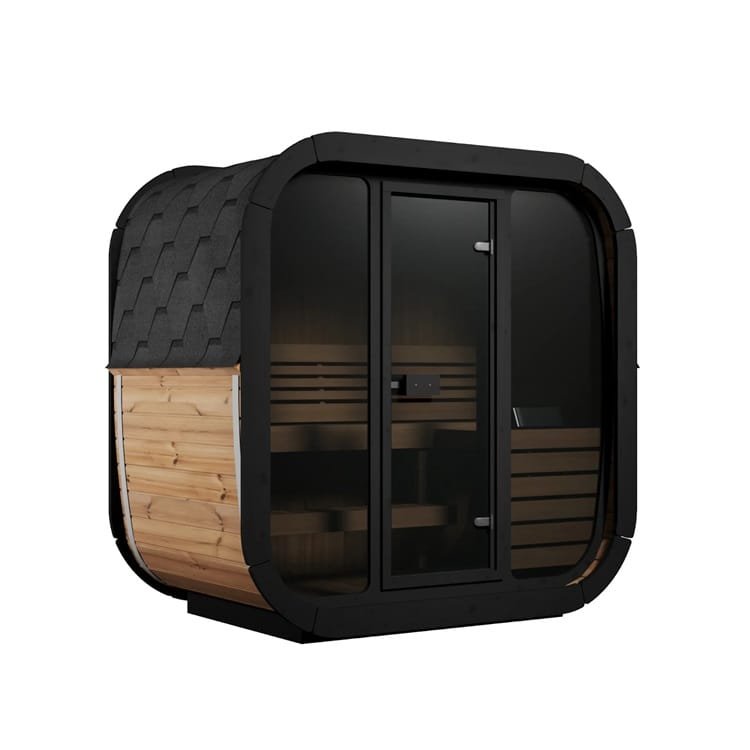
Outdoor Sauna Thermo Treated Spruce UNION 125 (2 – 4 Person) EURO
Dimensions: 196 cm × 105 cm × 190 cm tall
Volume: 3.91 m³
Suggested Heater Requirement: 4.5 or 6 kW

Outdoor/Indoor Western Red Cedar Barrel Sauna 2 – 4 Person
Dimensions: 150 cm Length × 200 cm Diameter × 150 cm Height
Volume: 4.71 m³
Heater Requirement: 4.5 to 6 kW
4-8 Person Sauna
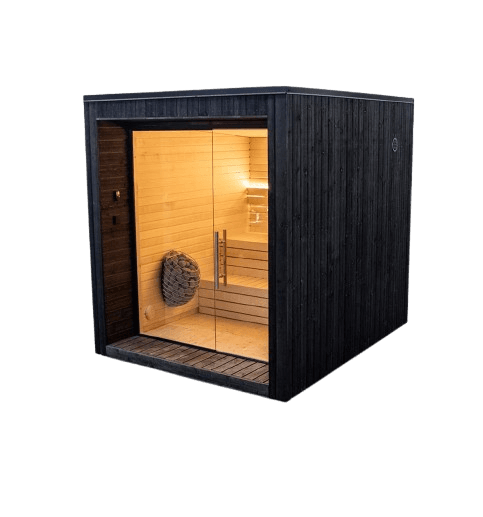
Outdoor Nordic Spruce Sauna ECLIPSE M EURO
Internal Dimensions: 175 cm × 190 cm × 200 cm tall
Volume: 6.65 m³
Heater Requirement: 6 to 9 kW
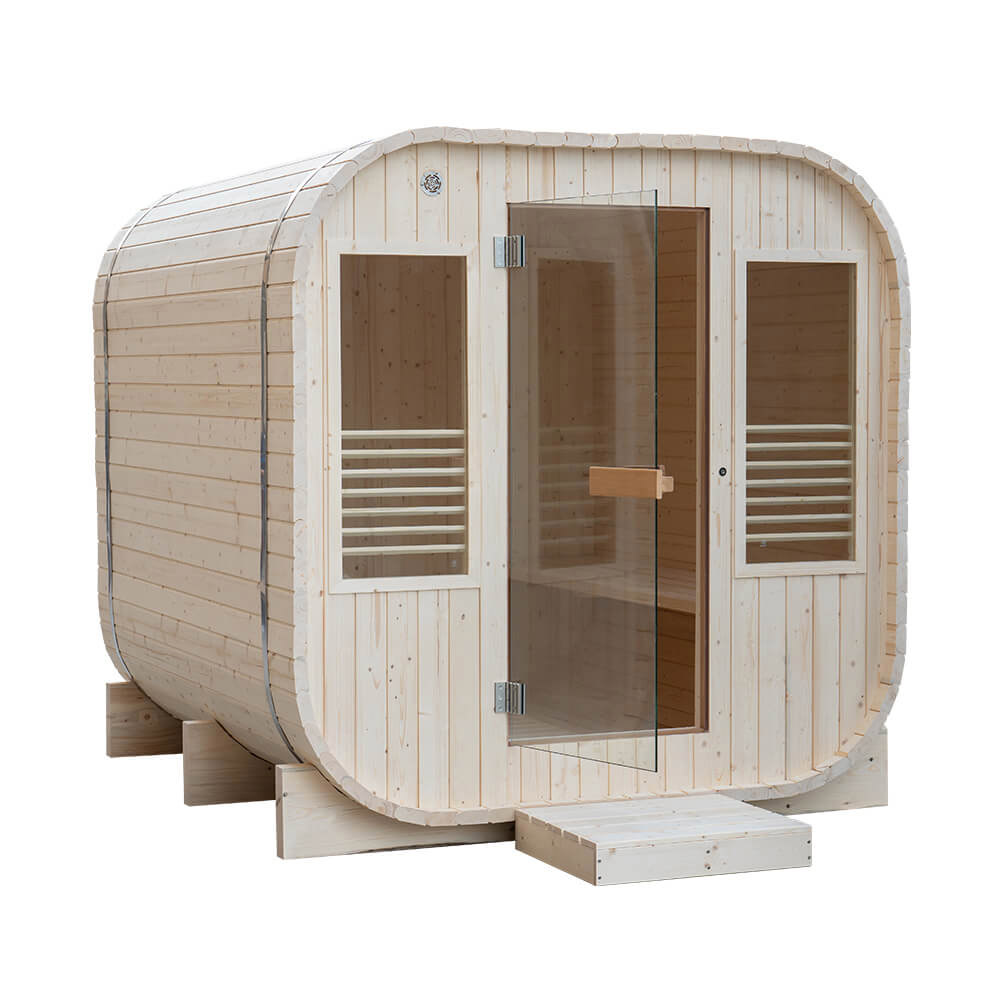
Outdoor/Indoor Spruce Square Barrel Sauna 4-8 Person
Dimensions: 180 cm × 210 cm × 210 cm tall
Volume: 7.94 m³
Heater Requirement: 8-9 kw Heater depending on the size
4-8 Person Sauna
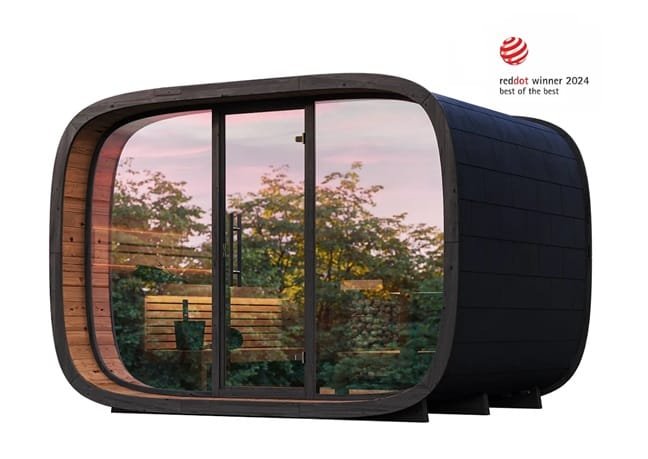
Outdoor Sauna Thermo Treated Spruce SERENITY ROUND CUBE SINGLE (3 – 10 Person) EURO
Internal Dimensions: 209 cm × 293 cm × 205 cm tall
Volume: 12.55 m³
Heater Requirement: 9-11 kW Heater depending on the size
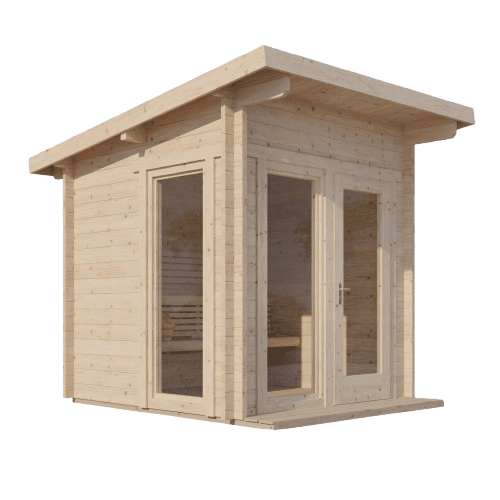
Outdoor Spruce Log Sauna CUBE (4 – 10 Person) EURO
Internal Dimensions: 200 cm × 200 cm × 210 cm tall
Volume: 8.40 m³
Heater Requirement: 9 to 11 kW depending on customer preference
Conclusion
Enjoy your sauna to the fullest by understanding how to run it efficiently. With the right approach, you can relax, improve your health, and elevate your space while keeping costs and environmental impact in check.
Ready to invest in a sauna or upgrade your setup? Explore our premium saunas, firewood, and electrical heaters at Shym Saunas. Designed for efficiency, comfort, and sustainability, our products help you create the ultimate sauna experience. Visit us today to find the perfect solution for your needs!
Frequently Asked Questions (FAQ) About Sauna Running Costs
1. How long does it take to heat a sauna?
The time required to heat a sauna depends on the size of the sauna and the type of heater:
- Electric Saunas: Typically take 30–45 minutes to reach the desired temperature.
- Firewood Saunas: Require about 40–60 minutes, as the fire needs time to establish before effectively heating the space.
2. Are there additional costs beyond electricity or firewood?
Yes, potential additional costs include:
- Maintenance Costs: Cleaning heaters, chimneys (for firewood saunas), and repairing or replacing worn components.
- Replacement Parts: Sauna stones, heater components, or fire grates.
- Water Use: If your sauna uses water for steam, minimal water costs may apply.
3. Can I reduce running costs with off-peak electricity rates?
Yes, scheduling sauna sessions during off-peak hours can significantly lower electricity costs. Many Australian providers offer cheaper rates during late evenings or early mornings.
4. Is it more cost-effective to use a small sauna?
Smaller saunas are typically more cost-effective because they require less energy or firewood to heat. For example:
A 2-4 person sauna uses 2.5–4 kW of power, while an 8-10 person sauna may require 6–10 kW.
5. How often should I clean my sauna stove?
- Electric Stoves: Clean every 3–6 months or as needed to remove dust and debris.
- Firewood Stoves: Clean the chimney and stove after every 20–30 uses to prevent creosote (a sticky, black, tar-like substance that builds up inside the chimney or flue of a wood-burning stove or sauna) buildup and ensure proper ventilation.
6. What’s the lifespan of an electric sauna heater?
An electric sauna heater typically lasts 10–15 years, depending on usage frequency and maintenance. Regular servicing can extend its lifespan.
7. Can I use alternative woods like softwoods in a firewood sauna?
Softwoods like pine and cedar are great for kindling but not ideal for sustained heating due to their high resin content, which can cause creosote buildup. Stick to hardwoods like oak, birch, or ash for primary heating.



